Appendix B: Foodservice Equipment
Learning Objectives:
- Identify equipment used in commercial foodservice kitchens.
- Select appropriate commercial equipment to use in a quantity foodservice recipe originally written for home use.
Key Terms:
- Rangetop

- Flattop
- a type of cooking range whose surface is sort of a cross between a griddle and a grill. Unlike a grill, a flat top doesn’t have a grate, but simply a flat cooking surface.
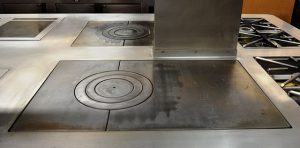
Flat top range. By M from Wikimedia Commons –CC0 Public Domain
- a type of cooking range whose surface is sort of a cross between a griddle and a grill. Unlike a grill, a flat top doesn’t have a grate, but simply a flat cooking surface.
- Induction Cooktop
- A stove where your pan is heated by a magnetic field instead of having its bottom sitting on a flame with a gas cooktop or on an element with an electric stove.
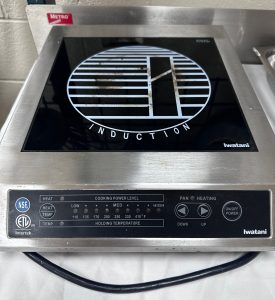
- Ovens
- Conventional
- An oven that uses radiant heat (such as from burners or heating elements) to heat; and does not use a fan to recirculate heated air or electromagnetic induction or other means to heat.
- Conventional

- Convection
- An oven that has a fan with a heating element around it. A small fan circulates the air in the cooking chamber.

- Combi
- an oven with three functions: convection, steam and combination cooking.

- Broilers and Salamanders
- a grill characterized by very high temperature overhead electric or gas heating elements.
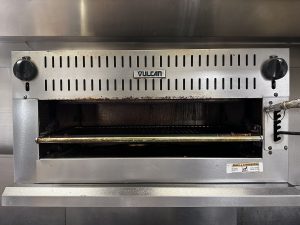
- Grill
- a metal framework used for cooking food over an open fire; a gridiron.

- Deep Fat Fryer
- A heated vessel for frying food by immersing in hot fat or oil, as opposed to shallow frying in a frying pan.

- Tilt Skillet
- a versatile restaurant appliance that holds 30 gallons and can be used to simmer, steam, braise, roast, saute, fry, boil or broil.
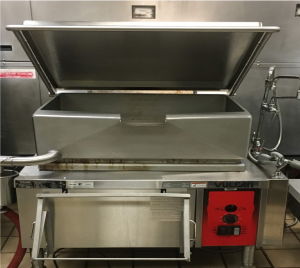
- Steam-Jacketed Kettles
- an improved, self-contained version of the large stockpot used for range top cooking. Steam kettles are often used to boil pasta, simmer sauces, stocks and stews.
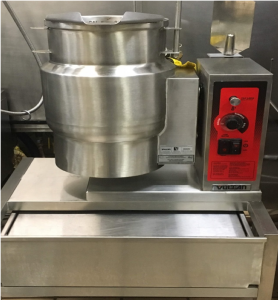
- Steam Cookers
- a kitchen appliance used to cook or prepare various foods with steam heat by means of holding the food in a closed vessel reducing steam escape.

- Mixers
- a kitchen utensil that uses a gear-driven mechanism to rotate a set of beaters in a bowl containing the food to be prepared which automates the repetitive tasks of stirring, whisking or beating.
- Bench
- a mixer which sits on a counter and has hinges to allow the beaters to rise out of the mixing bowl.
- Bench
- a kitchen utensil that uses a gear-driven mechanism to rotate a set of beaters in a bowl containing the food to be prepared which automates the repetitive tasks of stirring, whisking or beating.

- Floor
- A large mixer which is 3 to 4 feet tall and sits on the floor.

- Attachments
-
- Paddle
- an accessory for a mixer that spins to mix the contents of the mixer’s bowl.
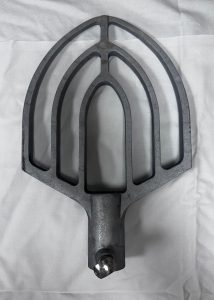
- Paddle
- Wire Whip
- Also called a whisk, this is a cooking utensil that fits into a mixer and can be used to blend ingredients smooth or to incorporate air into a mixture.
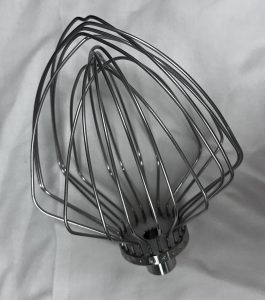
- Dough Arm
- a metal helical accessory for a mixer used to make dough.
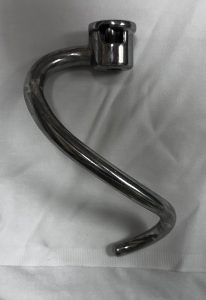
- Buffalo Chopper (Food Chopper)
- Slicer
- a tool used in butcher shops and delicatessens to slice meats, sausages, cheeses and other deli products. Also called a slicing machine, deli slicer or a meat slicer.

Metal meat slicer. By Sailko from Wikimedia Common –CC-BY - Food Processor
- an electric appliance with interchangeable blades within a closed container into which food is inserted for slicing, shredding, mincing, chopping, puréeing, or otherwise processed at high speeds.

Food Processor. By Your Best Digs on Flickr –CC-BY - Blender
- Burr Mixer (Immersion Blender)
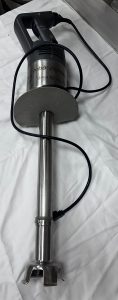
- Sous Vide
- Immersion Circulator: an electrical appliance used for sous vide cooking that is immersed in a container of water and that circulates and heats the water to a precise, consistently maintained temperature.

Sous Vide. By Erikoinentunnus on Wikimedia Commons –CC-BY-SA - Vacuum Sealer
- a device that enables a method of packaging that removes air from the package prior to sealing. This method involves (manually or automatically) placing items in a plastic film package, removing air from inside, and sealing the package.

Vacuum Sealer. By BBCLCD on Wikimedia Commons –CC-BY - Steam Table
- A steam table is used to hot hold food at a safe serving temperature after it is cooked. In the table, there are recessed openings (“wells”) that hold food pans, which are heated by a water bath to keep food warm for buffets.
- Cold Food Storage Equipment
- Cooler – Walk-in & Reach-in
- an enclosed storage space refrigerated to temperatures equivalent to a normal refrigerator that can be walked into, and has a total chilled storage area of less than 3,000 square feet.

Walk-in & reach-in cooler. By Sarah Oh on Flickr –CC-BY-NC-SA
- an enclosed storage space refrigerated to temperatures equivalent to a normal refrigerator that can be walked into, and has a total chilled storage area of less than 3,000 square feet.
- Cooler – Walk-in & Reach-in
- Reach-in
- an enclosed storage space refrigerated to temperatures equivalent to a normal refrigerator and is closer in size to a household refrigerator than a walk-in cooler.

Reach-in cooler. By Barebibotra on Wikimedia Commons –CC-BY-SA - Freezer – Walk-in & Reach-in
- an enclosed storage space refrigerated to temperatures equivalent to a freezer that can be walked into, and has a total storage area of less than 3,000 square feet.
-
- Cold Pass-through
- a combination of a walk-in and reach-in cooler where you can enter the refrigerated area and stock the shelves in the back, while customers can access the refrigerated products through glass doors on the front.

- Cold drawers
- Refrigerated storage that opens like drawers.

- Pots & Pans
- Saucepot
- Brazier/Rondeau
- a cross between a pan and a pot, this pot is about 3-4 inches deep and about 1 foot in diameter with 1 long handle or 2 on either side and a lid.

Brazier/Rondeau. By Erik Streb on Wikimedia Commons –CC-BY-SA
- a cross between a pan and a pot, this pot is about 3-4 inches deep and about 1 foot in diameter with 1 long handle or 2 on either side and a lid.
- Saucepan
- Sauté Pan
- Straight
- Sloped
- a pan with a wide flat bottom and sloped sides 3-4 inches high with a long handle on one side.

Sloped pan. By Cooks & Kitchens on Wikimedia Commons –CC-BY
- a pan with a wide flat bottom and sloped sides 3-4 inches high with a long handle on one side.
- Cast Iron Skillet
- Double Boiler
- Sheet Pan
- Baking Pan
- deeper than a sheet pan at about 3-4 inches and used for cooking meats.

Baking pan. By Michael J. Bennett on Wikimedia Commons –CC-BY-SA
- deeper than a sheet pan at about 3-4 inches and used for cooking meats.
- Roasting Pan
- a piece of cookware 5-6 inches deep typically with a lid used for roasting meat in an oven, either with or without vegetables or other ingredients. A roasting pan may be used with a rack that sits inside the pan and lets the meat sit above the fat and juice drippings.

Roasting pan. By Carol VanHook on Flickr –CC-BY-SA
- a piece of cookware 5-6 inches deep typically with a lid used for roasting meat in an oven, either with or without vegetables or other ingredients. A roasting pan may be used with a rack that sits inside the pan and lets the meat sit above the fat and juice drippings.
- Wok
- a versatile round-bottomed cooking vessel with a long handle, originating from China and used in a range of different Chinese cooking techniques, including stirfrying, steaming, panfrying, deep frying, poaching, boiling, braising, searing, stewing, making soup, smoking and roasting nuts.

Wok. By Clem Onojeghuo on Pexels –Pexels Photo Licensing Info
- a versatile round-bottomed cooking vessel with a long handle, originating from China and used in a range of different Chinese cooking techniques, including stirfrying, steaming, panfrying, deep frying, poaching, boiling, braising, searing, stewing, making soup, smoking and roasting nuts.
- Hotel Pan
- Bain Marie
- Scales
- Portioning Scale

Portioning Scale. By Unknown on Pxhere –CC0 - Digital Scale

Digital Scale. By xw7229525 on Pixabay –CC0 - Volume Measures
- Liquid
- Measuring Cups

Measuring cup. By HomeSpot HQ on Flickr –CC-BY - Measuring Spoons

Measuring spoons. By Julie Magro on Flickr –CC-BY - Portion Control Tools
- Ladles

Ladles. By Graeme Bartlett on Wikimedia Commons –CC-BY-SA - Scoops/Dishers
- Spoodles
- Solid
- Perforated
- Thermometers
- Bimetallic
- Meat
- a thermometer used to measure the internal temperature of meat, especially roasts and steaks, and other cooked foods.

Thermometer. By Steven Jackson on Flickr –CC-BY
- a thermometer used to measure the internal temperature of meat, especially roasts and steaks, and other cooked foods.
- Thermocouple

Thermocouple. By Harke on Wikimedia Commons –CC-BY-SA - Instant Read
- Knives
- Chef’s (French)
- Santoku
- a medium-sized, multipurpose kitchen knife of Japanese origin that has a lightweight blade with a straight or slightly curved cutting edge and a spine that curves downward to the tip. The santoku has long been the Japanese equivalent of a chef’s knife.

Santoku. By Plonk420 on Wikimedia Commons –CC-BY-SA
- a medium-sized, multipurpose kitchen knife of Japanese origin that has a lightweight blade with a straight or slightly curved cutting edge and a spine that curves downward to the tip. The santoku has long been the Japanese equivalent of a chef’s knife.
- Utility
- The utility knife was originally a fixed blade knife with a cutting edge suitable for general work such as cutting hides and cordage, scraping hides, butchering animals, cleaning fish, and other tasks.

Utility Knife. By Simon Speed on Wikimedia Commons –CC0
- The utility knife was originally a fixed blade knife with a cutting edge suitable for general work such as cutting hides and cordage, scraping hides, butchering animals, cleaning fish, and other tasks.
- Paring
- Boning
- Slicer
- Serrated
- Butcher
- Clam
- Oyster
- a short, thick blade that is used to pry open oysters and separate their meat from the shell (shucking).

Oyster Knife. By VIUDeepBay on Wikimedia Commons –CC-BY
- a short, thick blade that is used to pry open oysters and separate their meat from the shell (shucking).
- Vegetable Peeler
- a kitchen tool consisting of a slotted metal blade attached to a handle that is used to remove the outer skin or peel of certain vegetables.

Vegetable Peeler. By Peter Halasz on Wikimedia Commons –CC-BY-SA
- a kitchen tool consisting of a slotted metal blade attached to a handle that is used to remove the outer skin or peel of certain vegetables.
- Tomato Shark
- Sharpening Steel
- a rod of steel, ceramic or diamond-coated steel used to realign/sharpen blade edges.

Sharpening Steel. By Donovan Govan on Wikimedia Commons –CC-BY-SA
- a rod of steel, ceramic or diamond-coated steel used to realign/sharpen blade edges.
- Hand Tools & Small Equipment
- Parisienne Scoop
- is a small spoon-like tool used to cut round- or oval-shaped sections of melon, known as a melon baller, by pressing them into the melon’s flesh and then rotating. It can also be used to cut other soft fruit and ice cream.

Parisienne Scoop. By Alan Levine on Wikimedia Commons –CC-BY
- is a small spoon-like tool used to cut round- or oval-shaped sections of melon, known as a melon baller, by pressing them into the melon’s flesh and then rotating. It can also be used to cut other soft fruit and ice cream.
- Cook’s fork
- A type of fork that is used for many different cooking tasks when working with a variety of different foods that are boiled, baked, cooked, stir-fried, or grilled. Cooking forks may be very short in length to enable smaller foods to be moved or removed from pans or they may be longer in length and larger in size to keep hands away from heat and to enable larger food items to be easily handled.

Cook’s fork. By UNC Sea Grant College Program on Flickr –CC0
- A type of fork that is used for many different cooking tasks when working with a variety of different foods that are boiled, baked, cooked, stir-fried, or grilled. Cooking forks may be very short in length to enable smaller foods to be moved or removed from pans or they may be longer in length and larger in size to keep hands away from heat and to enable larger food items to be easily handled.
- Palette knife
- A palette knife is a knife with a broad, flat, flexible blade used in cooking, or in painting to apply oil paint to a canvas or other surface.

Palette knife. By Just plain Bill on Wikimedia Commons –CC0
- A palette knife is a knife with a broad, flat, flexible blade used in cooking, or in painting to apply oil paint to a canvas or other surface.
- Sandwich spreader
- Offset Spatula
- Rubber Spatula
- a flat thin implement used especially for spreading or mixing soft substances, scooping, or lifting.

Rubber Spatula. By Marco Verch on Flickr –CC-BY
- a flat thin implement used especially for spreading or mixing soft substances, scooping, or lifting.
- Pie Server
- A cake and pie server, also called a cake shovel, pie knife, crépe spade, pie-getter, pie lifter or cake slice, is a serving utensil used in the cutting and serving of pies and cakes. Some cake and pie servers have serrated edges. Another use can be to serve pizza.

Pie Server. By 3268zauber on Wikimedia Commons –CC-BY-SA
- A cake and pie server, also called a cake shovel, pie knife, crépe spade, pie-getter, pie lifter or cake slice, is a serving utensil used in the cutting and serving of pies and cakes. Some cake and pie servers have serrated edges. Another use can be to serve pizza.
- Bench Knife
- Pastry Wheel
- Spoons (metal, plastic)
- Slotted
- Perforated

Perforated Spoon. By Coyau on Wikimedia Commons –CC-BY-SA - Solid

Solid Spoon. By Donovan Govan on Wikimedia Commons –CC-BY-SA - Skimmer
- Tongs (metal, plastic) (short, medium, long-handled)
- a type of tool used to grip and lift objects instead of holding them directly with hands. There are many forms of tongs adapted to their specific use. Some are merely large pincers or nippers, but most fall into these few classes:
- Tongs that have long arms terminating in small flat circular ends of tongs and are pivoted at a joint close to the handle used to handle delicate objects. Common fire-tongs, used for picking up pieces of coal and placing them on a fire without burning fingers or getting them dirty are of this type. Tongs for grilling, tongs for serving salad or spaghetti are kitchen utensils of the same type. They provide a way to move, rotate and turn the food with delicate precision, or fetch a full serving in one grab.
- Tongs consisting of a single band of metal bent round one or two bands joined at the head by a spring, as in sugar-tongs (a pair of usually silver tongs with claw-shaped or spoon-shaped ends for serving lump sugar), asparagus-tongs and the like.
- Tongs in which the pivot or joint is placed close to the gripping ends are used to handle hard and heavy objects. Driller’s round tongs, blacksmith’s tongs or crucible tongs are of this type.

Tongs. By Sac86738 on Wikimedia Commons –CC0
- a type of tool used to grip and lift objects instead of holding them directly with hands. There are many forms of tongs adapted to their specific use. Some are merely large pincers or nippers, but most fall into these few classes:
- Chinois
- a conical sieve with an extremely fine mesh. It is used to strain custards, purees, soups, and sauces, producing a very smooth texture. It can also be used to dust food with a fine layer of powdered ingredients.

Chinois. By Laurent van Roy on Wikimedia Commons –CC-BY-SA
- a conical sieve with an extremely fine mesh. It is used to strain custards, purees, soups, and sauces, producing a very smooth texture. It can also be used to dust food with a fine layer of powdered ingredients.
- Wire Mesh Strainer
- A sieve, or sifter, is a device for separating wanted elements from unwanted material or for characterizing the particle size distribution of a sample, typically using a woven screen such as a mesh or net or metal.

Wire Mesh Strainer. By jhusemannde on Pixabay –CC0
- A sieve, or sifter, is a device for separating wanted elements from unwanted material or for characterizing the particle size distribution of a sample, typically using a woven screen such as a mesh or net or metal.
- Tamis
- A tamis (pronounced “tammy”, also known as a drum sieve, or chalni in Indian cooking) is a kitchen utensil, shaped somewhat like a snare drum, that acts as a strainer, grater, or food mill. A tamis has a cylindrical edge, made of metal or wood, that supports a disc of fine metal, nylon, or horsehair mesh. To use one, the cook places the tamis above a bowl and adds the ingredient to be strained in the center of the mesh.

Tamis. By João Carvalho on Wikimedia Commons –CC-BY-SA
- A tamis (pronounced “tammy”, also known as a drum sieve, or chalni in Indian cooking) is a kitchen utensil, shaped somewhat like a snare drum, that acts as a strainer, grater, or food mill. A tamis has a cylindrical edge, made of metal or wood, that supports a disc of fine metal, nylon, or horsehair mesh. To use one, the cook places the tamis above a bowl and adds the ingredient to be strained in the center of the mesh.
- Colander
- Food Mill
- A food mill (also called passatutto, purée sieve, moulinette, mouli légumes, or passe-vite) is a food preparation utensil for mashing and sieving soft foods.

Food Mill. By Rickwakenyc on Wikimedia Commons –CC0
- A food mill (also called passatutto, purée sieve, moulinette, mouli légumes, or passe-vite) is a food preparation utensil for mashing and sieving soft foods.
- Grater
- A grater (also known as a shredder) is a kitchen utensil used to grate foods into fine pieces. It was invented by François Boullier in the 1540s, originally to grate cheese.

Grater. By Donovan Govan on Wikimedia Commons –CC-BY-SA
- A grater (also known as a shredder) is a kitchen utensil used to grate foods into fine pieces. It was invented by François Boullier in the 1540s, originally to grate cheese.
- Zester
- A zester (also, citrus zester or lemon zester) is a kitchen utensil for obtaining zest from lemons and other citrus fruit.

Zester. By Steven Jackson on Flickr –CC-BY
- A zester (also, citrus zester or lemon zester) is a kitchen utensil for obtaining zest from lemons and other citrus fruit.
- Tomato Shark
- Mandolin
- a cooking utensil used for slicing and for cutting juliennes; with suitable attachments, it can make crinkle-cuts. Its name is derived from the wrist-motion of a skilled user of a mandolin, which resembles that of a player of the musical instrument mandolin.

Mandolin. By Alex Sims on Wikimedia Commons –CC-BY-SA
- a cooking utensil used for slicing and for cutting juliennes; with suitable attachments, it can make crinkle-cuts. Its name is derived from the wrist-motion of a skilled user of a mandolin, which resembles that of a player of the musical instrument mandolin.
- Pastry Bag
- A pastry bag (or piping bag in the Commonwealth) is an often cone- or triangular-shaped, hand-held bag made from cloth, paper, or plastic that is used to pipe semi-solid foods by pressing them through a narrow opening at one end, for many purposes including cake decoration. It is filled through a wider opening at the opposite end, rolled or twisted closed, and then squeezed to extrude its contents.

Pastry Bag. By Polyparadigm on Wikimedia Commons –CC-BY-SA
- A pastry bag (or piping bag in the Commonwealth) is an often cone- or triangular-shaped, hand-held bag made from cloth, paper, or plastic that is used to pipe semi-solid foods by pressing them through a narrow opening at one end, for many purposes including cake decoration. It is filled through a wider opening at the opposite end, rolled or twisted closed, and then squeezed to extrude its contents.
- Pastry Brush
- Can Opener






















